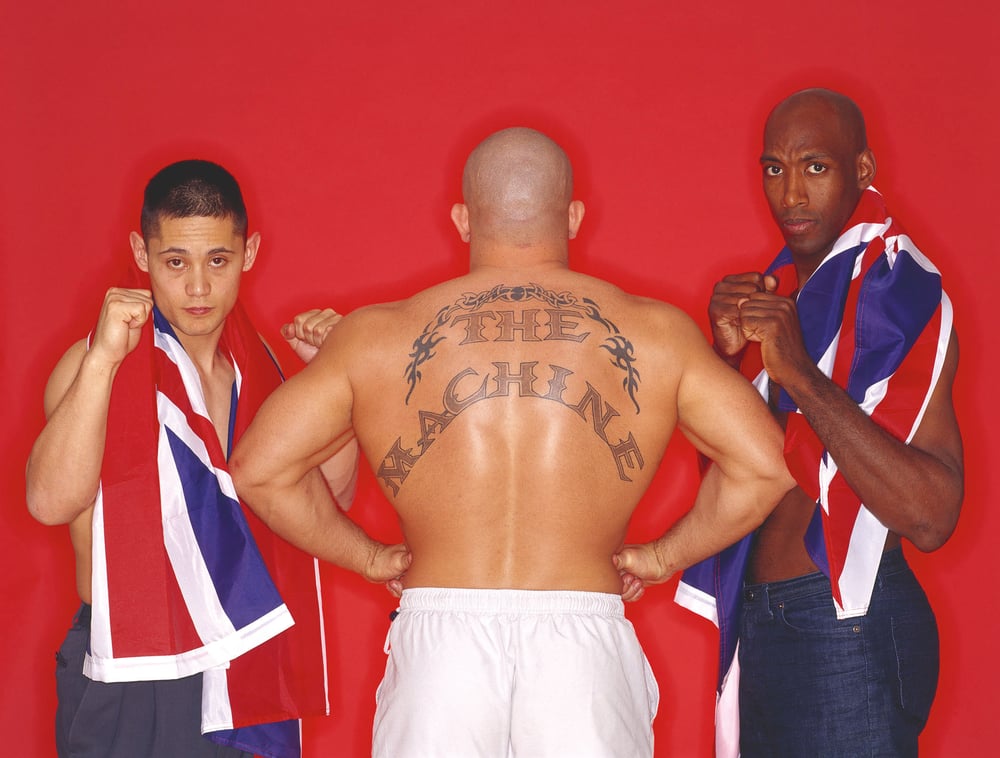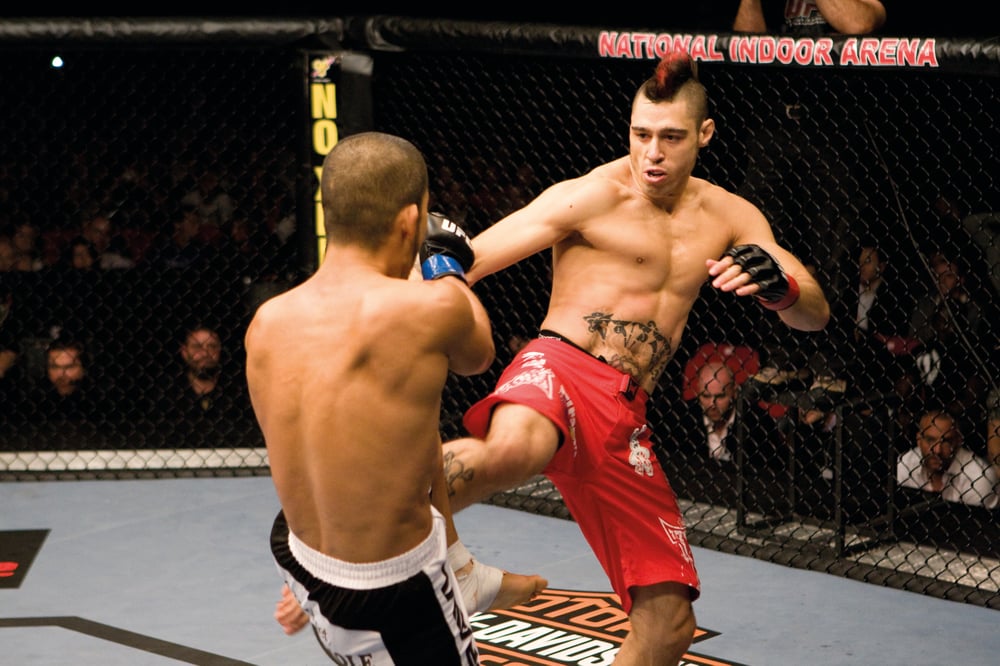
Issue 050
June 2009
It simply isn’t possible to write a full, comprehensive history of MMA in the UK within the pages of a magazine. Only a book could do such a diverse, vibrant scene the proper justice. But with a little help from some of the scene’s true pioneers – Ian Freeman, Lee Hasdell, Mark Weir and Alex Reid – Andrew Garvey offers up a whistle-stop history of the sport in the UK.
The Dark Ages: 1993-1995
Right from the beginning, the pseudo-sport of ‘No Holds Barred’ fighting had at least some presence in the UK. Long before the Internet made it easy, VHS copies of UFC, Pancrase and Shooto tapes were available (if you knew where to look), often entering the country via tape traders and spreading from there through further copying. The humble SCART lead used to connect a pair of video recorders deserves a little of the credit for introducing the sport to what would quickly become a small, but very appreciative audience.
Less appreciative were sections of the traditional martial arts and boxing communities, thundering about the dishonourable barbarism of it all. When they devoted any space at all to the sport, British newspapers lazily parroted the type of nonsense that featured in the US media at the time.

Pioneering UK promoter and fighter Lee Hasdell remembers it well. “I did stories with all the major newspapers and they just twisted things around, made things up about how dangerous it was, lots of malicious lies and petty cheap shots.” These over-excited journalists were outraged that men were locked in a cage and ‘forced’ to fight, with no rules, no referees and no skill, and implored someone out there to think of the nation’s moral fibre and stop these death fights!
Opponents of the fledgling sport were particularly appalled when MMA shows started actually taking place in Britain, threatening the then-tiny audiences with complete and instantaneous moral disintegration at the sight of two willing participants competing in a sporting event.
Early Days: 1996-1999
The first UK MMA shows took place way back in 1996. As pioneering middleweight Mark Weir notes, it was a chaotic, barely organised scene back then. “You didn’t know if you’d be fighting with fingerless gloves or just with boxing gloves on. I fought with boxing gloves a few times and all you could do was kick, box or throw. You couldn’t really do any grappling. It was still mixed martial arts because you were using striking and submissions but it was very different to how it is today. Up until, about 1999 or the early 2000s you’d find lots of different rules and you’d just take whatever you could get. I was fighting heavyweights sometimes… a lot of fights had no striking to the head on the ground, more or less like the semi-pro fights you see now. But at that time it was all still developing and changing, even the UFC were putting in new rules and changing all the time.”
Little was reliably or officially recorded in that era and plenty of Britain’s pioneering fighters, like Weir and old rival, actor and all-around entertainer Alex Reid have huge gaps and omissions in their ‘official’ fighting records. Reid recalls “you’d have people going to shows but it was mostly friends and family, nothing like how it is now. We didn’t really view it as something with a future because we didn’t know where it was going. It was a pastime. Before ’98 I’d be paying to fight, paying to enter competitions, it was madness! There was a real lack of technique at that time too, we were way behind the Americans in terms of grappling.”
The first major MMA shows in Britain were the three Night of the Samurai events promoted by Hasdell in 1998 and 1999 in a Milton Keynes nightclub. While other UK shows were pulling in tiny audiences, Hasdell says “we were getting capacity crowds to those shows, 2500 people. We were pulling in more than kickboxing at the time. That’s why the local council didn’t shut us down. If we were running a show and 50 people were turning up, they could have easily shut us down but they didn’t want to be killing people’s joy. They’d cover their own arses in case something went wrong but they wouldn’t shut down something that was that popular.

“I spent an unbelievable amount of time, so many hours, in meetings with the local council and the police over a period of a couple of years.” Hasdell notes a few other difficulties with promoting shows in that era. “There’s a lot of things we take for granted now that were very different in the good old days, well, the old days really, because they weren’t all that good!
“I used to have to import gloves from Holland, you couldn’t just go out and buy some. There was no internet, or very little use of the internet. People would be writing me letters asking to fight on shows. Not emails, letters. It would take weeks to sort out some things that are much simpler now.” The sport was hardly a guaranteed money-maker either. “It cost so much money to run shows, especially when you were bringing fighters over from Japan, even when you had a big gate. I lost £18,000 of my own money on a show once. But generally, you’d make some money here, lose some there. That’s just how it was.”
A New Millenium: 2000-2001
In December 1999, Andy Jardine promoted the first Millenium Brawl featuring the ‘official’ fighting debut of a certain Lee Murray and a crowd-pleasing main event in which Ian Freeman gave American journeyman Travis Fulton a good pasting in one of the most significant fights in the sport’s very short British history.
Looking back, Freeman explains “Fulton was supposed to fight Scott Adams [at UFC 24] but broke his hand so they looked at Fulton’s record and I’d just beaten him so they invited me in. I’d never left the country before, not even to go on holiday and suddenly I’m on a plane, on my own, not even any cornermen with me and met up with Kevin Randleman at the airport. Then I was in the rules meeting with Randleman, Dan Severn and John McCarthy and all these people I’d only ever seen on video before. The whole thing was just surreal.”

Taking a gargantuan leap into the unknown, Freeman was the first Englishman to fight for the UFC. He lost to Adams but fought, and won, two UFC fights later that year. Freeman also blazed a trail for British fighters travelling abroad to seek out the best training partners, something that’s now commonplace. But in those days, with the British scene still somewhat primitive, Freeman’s trips to the US to work with the likes of Pat Miletich and Josh Barnett really helped him stand out from the pack.
With Freeman flying the flag overseas, the UK scene continued growing throughout 2000 and when Millenium Brawl returned for a run of shows in 2001 and 2002, the tiny Judo Centre in High Wycombe they called home became one of the most important venues for MMA in the UK.
At the time, Jardine’s promotion, with ties to well-connected US promoter/manager Monte Cox, a terrifyingly passionate fanbase and regular appearances by the likes of Murray and Weir, was the place to be for British fighters. By the end of 2001, after some superb performances and a string of first round victories, Weir signed a three-fight deal with the UFC. But ‘the Wizard’ wasn’t the only Englishman the still newly Zuffa-owned promotion were eyeing up. Dana White and the Fertittas had their sights set on Britain’s entire, ever-growing MMA fanbase.

UFC 38 and the Rise of UK MMA: 2002
2002 saw enormous changes in the UK. Promoter Paddy Mooney was first to use a cage for his aptly named Cage Wars promotion, debuting in February. The cage would quickly become one of the most recognisable, common elements of the UK scene, partly due to the UFC coming to the country for the first ever time.
In preparation for that July’s UFC 38 in London, the American-owned company Zuffa secured a TV deal with Sky Sports for six months of a weekly, one-hour programme showing old UFC fights. While that wouldn’t seem like much today, at the time that TV deal was a truly massive breakthrough. The UFC also did their best to educate the media, managing to actually get some positive newspaper stories written alongside the usual, tiresomely predictable rubbish. As Lee Hasdell notes “when UFC came over in 2002, that put an end to some of the petty media cheap shots. UFC coming over really rubber stamped it.”
As for UFC 38 itself, it was shown on pay-per-view, drew a little under 4,000 fans to the prestigious Royal Albert Hall, and was by far the biggest, most watched MMA event on UK soil at the time. Weir made his UFC debut KOing durable veteran Eugene Jackson in just ten seconds. Looking back, Weir sees that show as a massive turning point. “Really it all changed after UFC 38. After that was the first time I had people coming up to me, stopping me in the street, or just when you’d go into a sandwich shop and the guy making the sandwiches would start talking about UFC. And that was before the UFC was as big as it is today. I can’t imagine what it must be like for somebody like Michael Bisping, now its really gone through the roof.”
On the night the UK contingent, all of them genuine pioneers, went 2-2. Freeman joined Weir in the ‘Englishmen-with-an-unforgettable-win’ category (see this month’s Top 5). His crushing beatdown of Frank Mir was the perfect topping to an already amazing evening of MMA action, which featured fellow hometown heroes James Zikic and Leigh Remedios.

The importance of Freeman’s victory cannot be underplayed. Though Weir impressed, flash knockouts are quite common in MMA, and Freeman’s sustained assault on the super-slick Mir (who was being groomed for a shot at the heavyweight title) was a statement to viewers around the world: UK fighters are here, and you’d better get used to it.
Having spent (and lost) significant money on their English adventure, the UFC stayed away for almost five years. In their absence, the UK scene went through enormous changes, constantly growing, shifting and evolving.

Constantly Growing: 2002-2004
Aside from the new emphasis on the cage (and the widespread pant-wetting excitement of UFC 38), 2002 saw the birth of the new generation of promotions in the UK. March delivered the first Ultimate Combat, while Cage Warriors debuted in July and Cage Rage burst onto the scene in September. Millennium Brawl continued throughout the year before morphing into Extreme Brawl, a name change inspired by the group’s ever-growing links with Cox, promoter of the long-running Extreme Challenge in America’s Midwest.
Just as 2002 brought massive changes, plenty happened in 2003. Network television got its first regular taste of the sport as ITV broadcast 13 episodes of their ‘Caged Combat’ series. Taking a vaguely documentary-style approach, the late-night series of half-hour shows played a significant role in expanding the sport’s fanbase. And exactly one year on from UFC 38, London Shootfighters (by far the most successful MMA gym in the country at the time) made the leap into promotion with their highly ambitious, Extreme Force: Genesis event.
Headlined by Lee Murray’s fight with Jose ‘Pele’ Landi-Jons (see this month’s Top 5) it was hyped as the biggest thing to hit UK MMA since the UFC. Sadly, on the night, the line-up bore little relation to the one originally announced and the show apparently lost a significant amount of money since Extreme Force never returned for a second try.
The Boom Period: 2005-2006
In 2005 and 2006, the UK scene was dominated by two promotions: Cage Rage and Cage Warriors. Ultimate Combat closed up shop in late 2004, but not before launching the career of one of Britain’s most internationally famous fighters, James ‘the Colossus’ Thompson. Earlier in 2004, the Cage Fighting Championships debuted in Liverpool, running events at the historic Olympia theatre. They stuck around through 2005 and were replaced in 2006 by the still-running Cage Gladiators, ensuring the Olympia its status as one of UK MMA’s longest-running, most regular venues.

Before 2005, the UK scene was widely ignored by the international MMA community, but the expansion of Cage Rage soon changed that. Cage Rage co-promoters Geer and Dave O’ Donnell’s enthusiasm for a good scrap (and willingness to pay for big name international talent) ensured that every Cage Rage show in this period was a genuinely big event.
World-class fighters, such as Anderson Silva, Renato ‘Babalu’ Sobral, Matt Lindland, Melvin Manhoef and Vitor ‘Shaolin’ Ribeiro, all made multiple appearances alongside British pioneers, such as Freeman, Weir, Remedios and the next generation of rising British stars, such as Brad Pickett and Paul Daley. Cage Rage also made deals with Sky Sports for a delayed highlights show (later to become live broadcasts) had DVDs available in major high-street shops and forged links with other promotions, most notably Japan’s then-dominant Pride FC.
Freeman notes, “People give him a lot of stick, but Dave O’ Donnell, he’s put a lot of money and work into the sport over here and the sport wouldn’t have grown without him and people like him. He should get the praise where it’s due.”
To most MMA fans outside the country, Cage Rage simply was the UK MMA scene but, while the London-based promotion hogged the spotlight, Cage Warriors were building not just the UK scene, but the wider European one, particularly with their ambitious ‘Strike Force’ events.
Featuring a cast of high-quality European talent such as Bendy Casimir, David Baron and David Bielkheden, Cage Warriors also showcased a couple of future UFC stars in Michael Bisping and Dan Hardy. Bisping really made his pre-The Ultimate Fighter name with his electrifying, dominant Cage Warriors fights in Coventry, while Hardy built his reputation for being almost incapable of having a dull fight during his long Cage Warriors run.
Also of note was that 2005 saw the opening of the Wolfslair MMA Academy. Though it was born from its founders’ passion for MMA as their hobby, it soon grew into one of the country’s first fully-kitted, professional training facilities. It didn’t take long for it to attract nearby top talent, including one Mr Michael Bisping.
“When I joined the Wolfslair, it came at a very crucial time in my career. I was doing well I had won the Cage Rage belt and I was winning all my fights,” he says. “I needed a lot more help in developing my skills. Just working out in a cage every day, these things are massive. If you don’t train in a cage, you’re at a big disadvantage. When I joined the Wolfslair, I wasn’t looking for them, but I went there and saw the coaches and the facilities and I was blown away. I thought I’d be a fool not to be a part of this.”

The UFC Returns and Everything Changes: 2007-2009
In their near five-year absence the UFC still maintained a strong UK presence. With TV deals on Bravo and then Setanta, UK fans could watch plenty of the promotion’s events at home, and with the UFC’s triumphant return to these shores in April, they could catch it live as well.
After years of building up their regional, territorial power bases, no UK promotion had truly established themselves as a national organisation. Cage Rage had the most exposure, but had never even left London. With so many big stars, the brand name in the sport, a media and advertising blitz and a certain TUF3 winner named Michael Bisping under contract, the UFC easily became UK MMA’s number one national outfit, holding massively successful shows in Manchester, Belfast, London, Newcastle and Birmingham. UFC UK President Marshal Zelaznik explained the reasons behind the UFC’s absence and later return.
“We had success with UFC 38 in 2002 but there was a lot of work to do in the US and, as a company, we felt we had to get that work done in the US before looking to expand elsewhere. But the UK was always a major priority for us, the Brits love a good fight, they love the competition, and it was always a no-brainer that the UK would be a major market for us. We knew from our web traffic and TV ratings that we had a good base of fans in the UK so I came on board in late 2006 to open the UK office in London.”
The UFC’s return to the UK, which was significant as they had quite rightly identified it as prime expansion territory, was based on another vital ingredient: Michael Bisping. Along with spirited brawler Ross Pointon, Bisping was the first Englishman to appear on The Ultimate Fighter. Heavily tipped to blitz the competition in 2006’s TUF3, Bisping did just that, winning the light-heavyweight portion of the series but also demonstrating the kind of charisma and genuine star power that would soon make him one of the UFC’s most valuable commodities. Broadcast in the UK as well, TUF3 made Bisping the biggest star in the history of the sport over here.
“How did it feel [to win The Ultimate Fighter]? It felt amazing. I had always wanted to fight on the UFC and I had won The Ultimate Fighter, and then they were using my face on posters launching in the UK,” says Bisping. “I had to stop and pinch myself, it was amazing. Even now, I’ve fought in the main event twice, co-main event three times. I’m fighting on UFC 100. You can’t do this by yourself; I’ve been fortunate to have a very strong team behind me.”
The return of the UFC has helped bring enormous benefits to the UK scene as a whole. Looking for British talent to help pull in the locals on UK-based shows, plenty of British fighters have found themselves on the fast-track to UFC contracts. Once there, they have to demonstrate they can compete and people such as Paul Taylor, Terry Etim and Paul Kelly have more than proved they belong. The UFC’s excellent PR work has also eradicated the media prejudice against the sport. The UFC is now covered as a sport in both the online and print editions of major newspapers like The Sun, The Daily Star and The Telegraph.
The high profile of the UFC, the easy availability of television, DVD, proper media coverage, spectacular live events and home-grown heroes like Bisping have all helped to completely transform the sport’s image and public profile. As Lee Hasdell points out, “Its so big now, its everywhere I go. You see people wearing the t-shirts and everybody’s a cage fighter now. Whether they actually are or not, I’m not sure, but that’s what they all seem to say!”
Ian Freeman notes the impact the UFC has had on the many other smaller Shows that make up the UK scene. “[The UK scene] is so much bigger now than it used to be, so many more shows. I’m MC’ing about 40 shows a year now. There’s lots of these smaller shows but there’s a really big difference between them and the UFC.” With so many shows, there’s now an outlet for so many more people to compete in the sport, hoping to follow in the footsteps of people like Freeman, Bisping, Etim and the newest fighting superstar to emerge from the UK scene, Dan Hardy.
Along with public demand to see the sport live, these shows are being fed by the explosion of MMA gyms up and down the country, training the next generation of fighters at grass-roots level. For example, TUF3 veteran Ross Pointon is just one of many, many people doing their bit. Earlier this year, Pointon promoted the first-ever MMA show in his hometown of Stoke-on-Trent. The ever-likeable Pointon ensured positive coverage in the local paper and delivered an entertaining event that has served to cement MMA’s place on the local sporting scene.
In the last couple of years the UK scene has also become increasingly well-respected at an international level. Top British fighters routinely spend time training in the US, and the development of increasingly professional gyms at home has dramatically improved the training opportunities available to aspiring fighters.
The Wolfslair is the most famous example, and one that should serve as a blueprint for the future. Top international trainers such as 1990s Brazilian Vale Tudo veteran Mario ‘Sukata’ Neto, quality facilities and the presence of Michael Bisping have made it Britain’s most high-profile MMA gym, so much so that it’s even attracted top international fighters Quinton ‘Rampage’ Jackson and Cheick Kongo into the fold. News that a UFC superstar like ‘Rampage’ was heading to the UK to train would have been dismissed as a ludicrous rumour a few years ago, but now it’s a reality and just one more example of how far the UK scene has come.
“The sport is way more mainstream,” says Bisping. “There are several good magazines out there, with Fighters Only top of the pile obviously! Many websites, clothing brands… You name it, there is a whole lifestyle around it. Obviously there are a lot more people training, a lot more gyms. When I started at the Wolfslair it was the only place of it’s kind. I’d say you could find somewhere to train MMA in every town in the country. The growth has been huge.”
The Future of UK MMA
With the sport looking ever-more healthy at a grass-roots level and increasingly more respected internationally, the UK scene looks set to benefit from the trickle-down effect of the UFC’s runaway success for a long time. The UK can boast more TV coverage, there are more gyms springing up, more businesses capitalising on the growth of the sport and, most important of all, more opportunities for fighters.
“If you consider less than 30 guys tried out for TUF3 in early 2006 and nearly 300 tried out for TUF 9 two and a half years later, you get an idea of how fast MMA is growing in the UK,” says Zelaznik. “More and more young athletes are getting into this sport, so many in fact that we’ve been approached by several outreach charities to help them get youngsters involved in sport.
“The UFC’s shows are already the biggest indoor sporting events in the UK, but we can do, and will do, so much more. If you think there’s been a massive growth in the last three years, wait until you see what we do in the next three years here in the UK.”
Just a few years ago, it would have been unthinkable for more than a very select handful of British fighters to compete with their American counterparts. Now, TUF9 is based around a Bisping-led team of British fighters taking on Dan Henderson’s Team USA.
That represents yet another enormous leap forward and another of the seemingly ever-increasing opportunities for British fighters to not only compete in their chosen sport but to actually make it their full-time profession. What seemed unthinkable for the UK scene a decade ago is now a reality. Best of all, things look like getting even bigger and better in the next ten years.
Before They Were Famous
With the UFC-led worldwide explosion of MMA over the last few years, top British fighters have found themselves thrust into the international spotlight. With that in mind, the next MMA show in your local area may well include a star of the future. And there’s nothing quite like telling your mates you saw them early in their career and knew they’d be something special.

Dan Hardy
The UFC’s newest UK superstar, and now in his fifth year as a professional fighter, ‘the Outlaw’ has long been regarded as one of the UK scene’s brightest stars. A Cage Warriors mainstay, Hardy has been involved in some genuine British classics. Accustomed to hugely entertaining success at home, Nottingham’s finest has rarely failed to shine brightly on European soil. Marcus Davis beware…
Paul Daley
Best known internationally for his EliteXC fights in 2007 and 2008, ‘Semtex’ has been entertaining British crowds with his all-out attacking style since 2003. The 26-year-old Daley already has 30 professional fights under his belt. On home soil the Nottingham Rough House product was a 2004-2007 Cage Rage regular holding wins over many quality fighters.
Paul Taylor
Owner of a whopping three ‘Fight of the Night’ bonuses (all in defeat, to Marcus Davis, Paul Kelly and Chris Lytle) in his five-fight UFC tenure, the former kickboxing champion is one of the entire sport’s most reliably exciting, entertaining fighters. The UFC didn’t simply conjure Taylor out of thin air. A professional MMA fighter since 2002, ‘Relentless’ fought on the first two Cage Rage events.
James Thompson
Michael Bisping may be king of UK MMA’s castle but even he hasn’t pulled the kind of viewing figures as ‘the Colossus’. Thompson was part of the most watched MMA fight in North American history when he fought Kimbo, eventually losing a chaotically entertaining scrap. Also big in Japan, he fought there seven times with varying degrees of success. The titanic heavyweight’s career really kicked off in 2004. Thompson went 5-1 in domestic promotions, picking up a five-round decision win over MMA legend and pioneer, Dan Severn.
Rosi Sexton
Fighters Only’s very own Rosi Sexton spent three years fighting in the UK before making the jump to the world scene. Already a Cage Warriors champ (having beaten top European competition) Rosi has gone on to fight in the USA, Russia, Costa Rica and Canada. A true trailblazer, for a long time Rosi was the women’s MMA scene in the UK. Still the foremost female fighter to come from our small island, she continues to fight around the world.

Lightning Lee Murray
A few hours after Ian Freeman’s triumph over Frank Mir and Mark Weir’s stunning ten-second KO of Eugene Jackson at UFC 38, the British scene got its next internationally renowned fighter when Murray knocked out UFC star Tito Ortiz. Of course, that was in an infamously chaotic after-show rumble instead of an organised sporting event, but it got plenty of people talking and added to the near-legendary tales of Murray’s street-fighting prowess.
Tall, violently aggressive and possessing brutal knockout power, middleweight Murray was impressive inside the cage as well. Unfortunately, his career was bedevilled by problems with the law. Signed up to a UFC contract he fought just once in the Octagon, quickly beating Jorge Rivera with a triangle choke at UFC 46 in January 2004. Visa issues stopped him returning to the USA and his final MMA fight saw him outclassed but last the distance with Anderson Silva in September 2004.
A year later he was repeatedly stabbed outside a London nightclub in an attack that made national newspaper headlines. His incredible recovery (he was back in the gym a few weeks later) is the stuff of legend, but his suspected involvement in the February 2006 £53million Securitas robbery saw him arrested in Morocco a few months later and imprisoned on drugs charges. A Moroccan citizen benefiting from the lack of an extradition treaty between the UK and Morocco, Murray remains in North Africa.
The UK TUF 9 Team
THE LIGHTWEIGHTS
Jeff Lawson
Natural showman Jeff combines a slick grappling game with unorthodox attacks from arts such as judo and capoeira.
Ross Pearson
Tough North East-based fighter Ross’s nickname is ‘The Real Deal’. With a record of 9-3-1, he is one of the toughest young competitors in the UK.
Martin Stapleton
A physical training instructor for the Royal Marines, ‘Stapes’ is as tough as they come. Though he’s only been pro for 18 months, he’s already 5-1.
Andre Winner
26-year-old Andre Winner is a product of the Rough House fight team and counts Dan Hardy, Paul Daley and Jimmy Wallhead as his training partners.
THE WELTERWEIGHTS
Dean Amarasinghe
A former rugby player who’s career on the field was cut short due to injury, Amarasinghe is a powerful grappler who loves slamming his opponents.
David Faulkner
A Wolfslair-trained fighter who can boast Michael Bisping and Rampage Jackson as his sparring partners, Faulkner is a 2-1 leglock specialist.
Nick Osipczak
23-year-old Nick is a crafty, strategic fighter and university graduate who has trained with some of London’s top fighters.
James Wilks
An Englishman living in LA, 31-year-old James trains with the likes of Eric Paulson and Josh Barnett.











